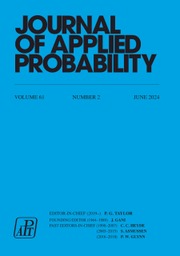Crossref Citations
This article has been cited by the following publications. This list is generated based on data provided by Crossref.
H�sler, J.
1977.
A remark on the strong law of large numbers.
Monatshefte f�r Mathematik,
Vol. 84,
Issue. 3,
p.
209.
Haratym, Z.
Kownacki, J.
Ludziejewski, J.
Sujkowski, Z.
De Geer, L.-E.
Kerek, A.
and
Ryde, H.
1977.
High-spin states and evidence for particle-core coupling in the N = 83 isotones: 143Nd, 145Sm and 147Gd.
Nuclear Physics A,
Vol. 276,
Issue. 2,
p.
299.
Stam, A. J.
1978.
Heavy traffic limit theorems in fluctuation theory.
Advances in Applied Probability,
Vol. 10,
Issue. 4,
p.
852.
Stam, A. J.
1978.
Heavy traffic limit theorems in fluctuation theory.
Advances in Applied Probability,
Vol. 10,
Issue. 4,
p.
852.
Petrov, V. V.
1982.
A limit theorem for sums of independent, nonidentically distributed random variables.
Journal of Soviet Mathematics,
Vol. 20,
Issue. 3,
p.
2232.
Chao, Chern-Ching
and
Slivka, John
1987.
Some exact distributions of the number of one-sided deviations and the time of the last such deviation in the simple random walk.
Stochastic Processes and their Applications,
Vol. 24,
Issue. 2,
p.
279.
Klesov, O. I.
1987.
A limit theorem for multiple sums of identically distributed independent random variables.
Journal of Soviet Mathematics,
Vol. 38,
Issue. 6,
p.
2321.
Klesov, O. I.
1993.
Convergence of the series of large-deviation probabilities for sums of independent equally distributed random variables.
Ukrainian Mathematical Journal,
Vol. 45,
Issue. 6,
p.
845.
Pruss, Alexander R.
1997.
A two-sided estimate in the Hsu—Robbins—Erdös law of large numbers.
Stochastic Processes and their Applications,
Vol. 70,
Issue. 2,
p.
173.
Spătaru, Aurel
1999.
Precise Asymptotics in Spitzer's Law of Large Numbers.
Journal of Theoretical Probability,
Vol. 12,
Issue. 3,
p.
811.
Gut, Allan
and
Spătaru, Aurel
2000.
Precise Asymptotics in the Baum–Katz and Davis Laws of Large Numbers.
Journal of Mathematical Analysis and Applications,
Vol. 248,
Issue. 1,
p.
233.
Gut, Allan
and
Spătaru, Aurel
2000.
Precise asymptotics in the law of the iterated logarithm.
The Annals of Probability,
Vol. 28,
Issue. 4,
Gut, Allan
2002.
Precise asymptotics for record times and the associated counting process.
Stochastic Processes and their Applications,
Vol. 101,
Issue. 2,
p.
233.
Wang, Yuebao
and
Yang, Yang
2003.
A general law of precise asymptotics for the counting process of record times.
Journal of Mathematical Analysis and Applications,
Vol. 286,
Issue. 2,
p.
753.
Gut, Allan
and
Spătaru, Aurel
2003.
Precise asymptotics in some strong limit theorems for multidimensionally indexed random variables.
Journal of Multivariate Analysis,
Vol. 86,
Issue. 2,
p.
398.
Scheffler, Hans-Peter
2003.
Precise asymptotics in Spitzer and Baum–Katz's law of large numbers: the semistable case.
Journal of Mathematical Analysis and Applications,
Vol. 288,
Issue. 1,
p.
285.
Csörgő, Sándor
2003.
Rates in the complete convergence of bootstrap means.
Statistics & Probability Letters,
Vol. 64,
Issue. 4,
p.
359.
Розовский, Леонид Викторович
and
Rozovskii, Leonid Victorovich
2004.
О точной асимптотике в слабом законе больших чисел для сумм независимых случайных величин с общей функцией распределения из области притяжения устойчивого закона. II.
Теория вероятностей и ее применения,
Vol. 49,
Issue. 4,
p.
803.
Hu, Zhishui
and
Su, Chun
2004.
A supplement to a theorem of Gut and Spătaru.
Journal of Mathematical Analysis and Applications,
Vol. 289,
Issue. 2,
p.
522.
Spătaru, A.
2004.
Exact Asymptotics in log log Laws for Random Fields.
Journal of Theoretical Probability,
Vol. 17,
Issue. 4,
p.
943.

